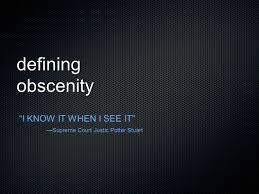Supreme Court Justice Potter Stewart, when asked to describe his test for obscenity, in 1964.
When it comes to K-12 curricular materials and library books, what, exactly, is “pornography”— and its corrupt cousin, obscenity? Do you know it when you see it?
Most parents, I think, have a good handle on what they think is appropriate reading / viewing for their children. As the omnipresent meme says, if you don’t want your children to read or watch something, fine—just don’t make everyone else follow your personal rules. I know parents who found Harry Potter frightening and disgusting, and parents who proudly say their children can read anything they like.
I actually think there are plenty of books that don’t belong in school libraries. But I worry way more about parents who let their school-age kids watch an unending stream of violence on TV, then tag along to the shooting range on weekends.
I don’t think books, per se, engender anti-social behaviors, especially when discussion follows reading. And while it would be lovely to think that schools can dish out value-free “content,” any teacher will tell you that managing classroom learning is a daily encounter with weighing and expressing values. The more you sterilize subject matter, boiling it down to a bunch-of-facts curriculum, the less sticky and engaging instruction becomes.
Thus—it bothers me to hear Christopher Rufo call school library books, even certain textbooks, “pornography.” He’s not just talking about sexually explicit stuff, either. He’s talking about a whole range of, well, values that he finds offensive: Delicate and careful discussions about race and discrimination. Questions around gender identity. The use of impious vocabulary. Characters who are decidedly not religious or Christian.
Pornography is something else.
I first encountered pornography in school, ironically enough. When I was in 10th grade, I was in the school play. It was a minor role—a half-dozen lines and maybe 10 minutes on stage. I can’t remember the name of the (forgettable) play, but my character’s name was Bunny. One of the other secondary characters was played by a girl named Pat, who wore copious black eyeliner and carried a metal rat-tail comb in her purse, both grooming tool and potential weapon.
There was a lot of waiting around for our bit on stage. Pat was always reading a paperback, sitting on the metal stairs up to the light booth. I didn’t think of Pat as an avid-reader type, but she was buried in that book. I asked her what she was reading—and she said it was really good, and I could borrow it when she was done.
It was a plain cover—no pictures. I stuck it in my tote bag with my geometry book and took it home. When I opened it up at home, holy tamales. It was—no two ways about it—porn. I read a little, then hid it back in the tote bag. I took it back to school and kept it in my locker for a few days, reading bits here and there—and, I have to admit, being exposed to things I never even heard of or considered.
We’re not talking about Lady Chatterley or Henry Miller or even Anais Nin. This was poorly written, printed on cheap stock, and raunchy. When I gave it back to Pat, she asked if I liked it. I said yes. And that was a true statement, even though it felt like a bomb when it was in my locker.
Did it hurt me, a relatively innocent 15 year old, to read that book? Nah. But there was a reason I kept it sequestered in my locker.
Nor did it hurt me to read Black Like Me, Naked Lunch or Lolita, all of which I read as a teenager.
Kudos to the Michigan Board of Education for proposing and passing a resolution last week supporting school librarians’ work as qualified decision-makers, when it comes to what should be shelved and available in their respective educational contexts (with the two Republican members voting no):
The board’s resolution calls on local school leaders to follow best practices in handling book challenges and affirms that school librarians have the professional skills to select age-appropriate materials. The board’s statement also recognizes that certified librarians have a positive impact on student’s learning and academic outcomes.
One of the two Republicans, Tom McMillin, promptly proposed another resolution to keep (here it comes) “pornography” out of school. That sentiment already exists in the School Code, so that feels just a bit performative, a chance for McMillin to say he fought for kids or some such. A chance to repeatedly use the word “pornography,” as if schools were the source of the actual porn that many teenagers consume.
My friend, Reverend Jeanne Hansknect, an Episcopal priest, said this, in her comments to the Community Library Board, as they dealt with charges of offering inappropriate literature: Reading breaks open our limited experiences one book at a time.
And that’s the real shame of restricting kids’ access to books: things that they learn from, and explore at their own pace, are labeled and locked up, making it harder to encourage broad perspectives and critical thinking. Making it harder for teachers to gin up enthusiasm for the basic process of reading, and harder to use language to teach rich, relevant content. Making it harder to look at the most challenging issues for all Americans, and think together about how to solve them.
None of this is really about skills—or even about obscenity or fake pornography.
It’s about politics. It’s about trigger words like “pornography,” and unsupported accusations. We know those unsupported words when we see them. And we’re not seeing them in school.


[…] Almost every edu-blogger wrote about book-banning this year, some with photos of empty shelves. My personal take explores the use of the word ‘pornography’ to describe books that have changed students’ lives, and my own first encounter with actual porn. I Know It when I See It. […]
LikeLike